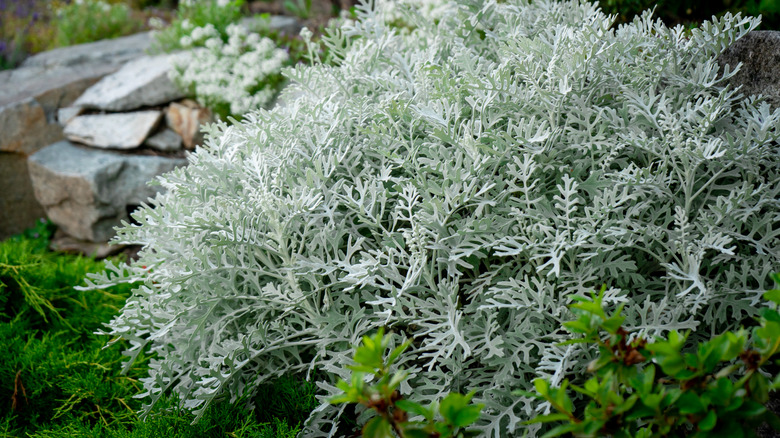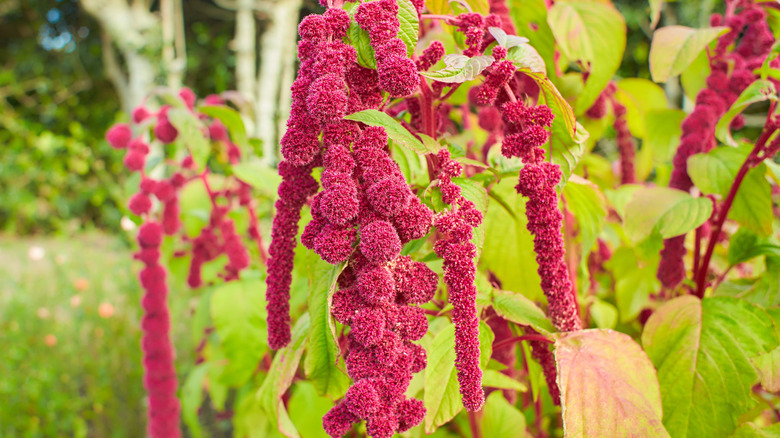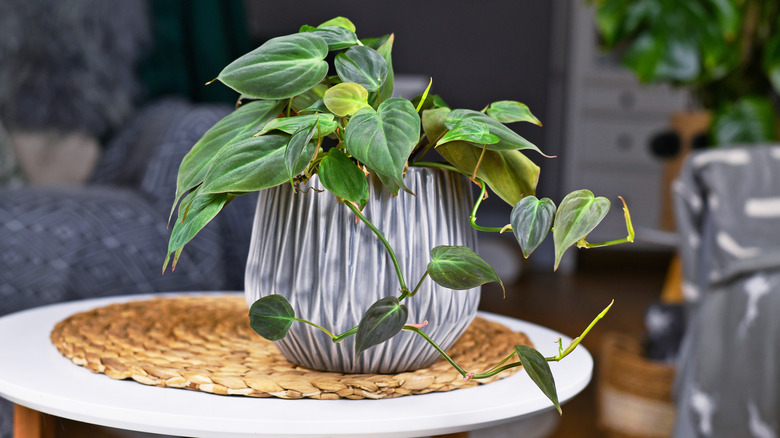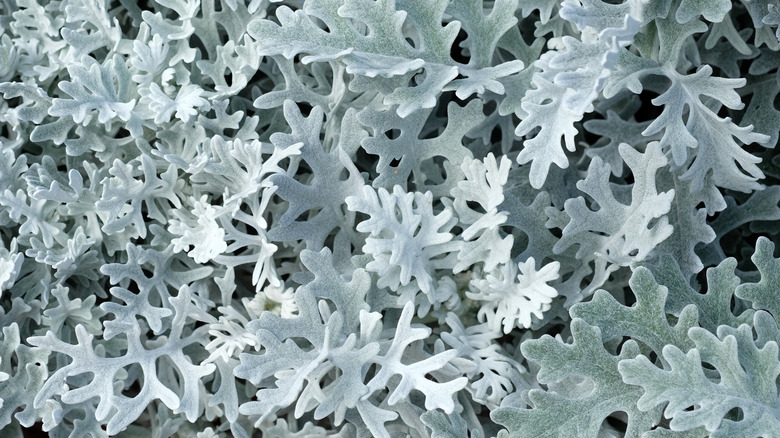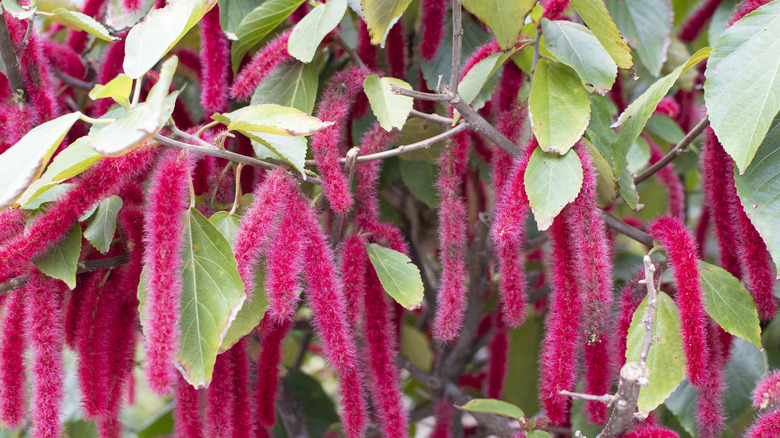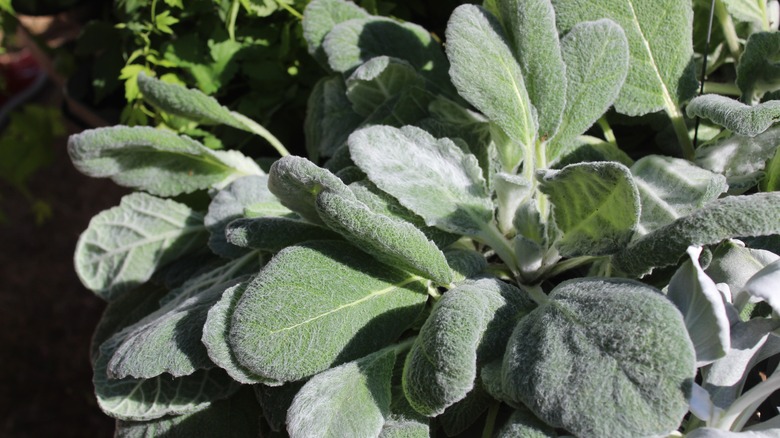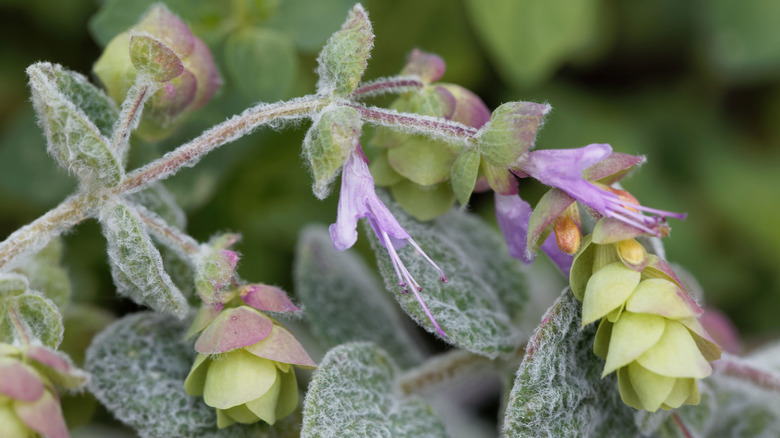Velvety Flowers And Plants That'll Add A Hint Of Luxury To Your Garden
Mastering the concept of aesthetic flower gardens, floral arrangements, and landscaping requires the ability to understand how plants and flowers can be grouped together in a way that complements one another while still allowing each individual to shine. The ideal way to accomplish this feat is to understand the ways in which different colors, shapes, sizes, and textures can all come together to create a unique and cohesive grouping, or accomplish a goal like bringing insects and birds to your garden.
One particularly interesting texture found on some flowers and plants is that of a fuzzy, hairy, woolly, or velvety nature. These soft, charming plants may seem cute and whimsical, but they're actually sporting natural defense mechanisms against threats like insects and frost. The hairs that make up the fuzzy coating on velvety plants are known as trichomes, and their natural job is to prevent frost and insects from reaching the surface of vulnerable leaves, stems, and flowers. When it comes to the aesthetics of a garden, flower bed, or houseplant arrangement, on the other hand, this soft texture adds a pop of visual interest. If you're looking for some fuzzy new plants to embrace, consider these luxurious, velvety wonders.
Love lies bleeding blooms with charming, puffy flowers
Love-lies-bleeding is a dramatically named, short-lived annual that can make a theatrical splash in your summer flower garden. While its broad green leaves might not stand out in a crowd, its hanging tassels of showy, fuzzy red and purple flowers certainly do. While this plant is technically edible, it is almost exclusively grown for its ornamental value and innate ability to spice up any summer flowering annual garden with some much-needed exotic flair.
You can grow this plant in many types of soil or perlite — it is adaptable and drought-tolerant too, so watering is rarely necessary. It does, however, require full sun. Enjoy its beauty until the blooms brown and die. If you'd like to regrow more love-lies-bleeding the following year, remove the dead flowers and dry them. Once dried, you can remove the flowers' seeds and save them for future planting.
Velvet philodendron grows quickly in warm climates
Velvet philodendron — also known as philodendron micans — is a tropical perennial that is often grown as a houseplant or outdoors in USDA zones 11a-12a. It features large, iridescent, heart-shaped pink, purple, and green velvet-covered leaves on vines. The plant's leaves start off their lives with a bronzy pink hue and then mature into a darker, deep green. Velvet philodendrons that get more light will produce more reddish leaves, while those that get less light will feature greener foliage.
This truly tropical velvety plant requires bright indirect light and warm temperatures. It is useful to keep them in pots so that they can easily be moved indoors on all but the warmest and driest of days. Just be careful not to make the mistake of overwatering. You should only water the plant when the top two to three inches of its soil feels completely dry to the touch. It is also a very fast-growing plant, so be ready to frequently repot it whenever its roots begin to protrude. Please note that velvet philodendron is toxic to pets and should be kept away from cats and dogs.
Dusty miller has enchanting, lacy leaves
If silvery, iridescent-looking plants are your favorite variety of velvety botanical, dusty miller might be the perfect fit for your garden. This Mediterranean perennial sub-shrub is often grown as an annual in cooler climates. The plant's green lacy foliage is covered with fine silvery white hairs. While it occasionally produces yellow thistle flowers, most gardeners opt to snip these buds since their beauty doesn't quite stand up to the dusty miller's shimmering foliage.
Dusty miller plants are best planted in an outdoor container, as landscape edging, or as an accent in the flower garden. This small shrub requires consistently moist soil, so be ready to provide water regularly. It also thrives when located in full sun, although where dusty miller really shines is under the night sky. Known for reflecting moonlight, it is a plant that makes a great addition to nighttime moon gardens. For those who like a little moonlit mystery in their lives, dusty miller is an excellent addition.
Chenille plant is a fun, fuzzy addition to a tropical garden
Looking for a plant that will make your garden stand out? The chenille plant is at your service. This striking tropical perennial is grown as an annual unless you are one of those who are lucky enough to live in zones 10-12. The plant's claim to fame is its long, bright red, fuzzy flowers, which sort of resemble spicy Hot Cheetos. These unusual flower tassels are accompanied by large, vibrant green, toothed leaves.
Due to the hanging nature of the chenille plant's flowers, which can grow up to 18 inches long, they are best suited for hanging baskets in a patio or balcony garden. As a truly tropical specimen, the chenille plant requires bright light and prefers warm and humid conditions. You'll need to keep its soil moist at all times. However, you should never mist a chenille plant. In fact, avoid wetting its flowers whenever possible to prevent disease. This plant loves food, especially when it is flowering; feel free to add a water-soluble fertilizer to its regular waterings. Sadly, the quality of a chenille plant drastically diminishes after its first year, so it's best to take cuttings and grow yourself a new plant annually.
Silver sage makes a splendid addition to moon gardens
For those who are tempted by the idea of a shimmery nighttime garden, silver sage is another plant that features silver-white wooly hairs perfect for producing an ethereal moonlit glow. A Mediterranean biennial in the mint family, silver sage boasts large green rosette leaves covered in silver hairs and also eventually produces fuzzy white flowers. Like all biennials, silver sage completes its full life cycle within two years.
The silver sage plant can grow in either full sun or partial shade and does not need much water. Its drought-tolerant nature means that it is susceptible to diseases like root rot and powdery mildew when overwatered. It is possible to treat powdery mildew but best to avoid it altogether. Unfortunately, slugs and snails seem to love silver sage as much as gardeners do, so you may want to keep a pet-safe insecticide on hand.
Dittany adds velvety beauty but needs little maintenance
Dittany — also known as wild oregano — is an edible Mediterranean herbaceous perennial plant that produces mounds of small, round, silver-haired leaves. In addition to this luxurious velvety foliage, the plant grows charming purplish bracts and flowers during the summer season. The flowers are known to attract butterflies and bees, so this is a good choice for an insect-friendly garden. Since dittany can spread aggressively under certain conditions, it may be best to place it around your garden in containers rather than planting it directly in the ground.
Dittany can grow in either full or partial sun and prefers dry, well-drained soils, making it a low-maintenance plant. Like silver sage, it is a drought-resistant plant and cannot tolerate overwatering or high humidity without the threat of root rot taking hold. Cutting back flowers as soon as they begin to wither can help new healthy leaves to grow in their place.
